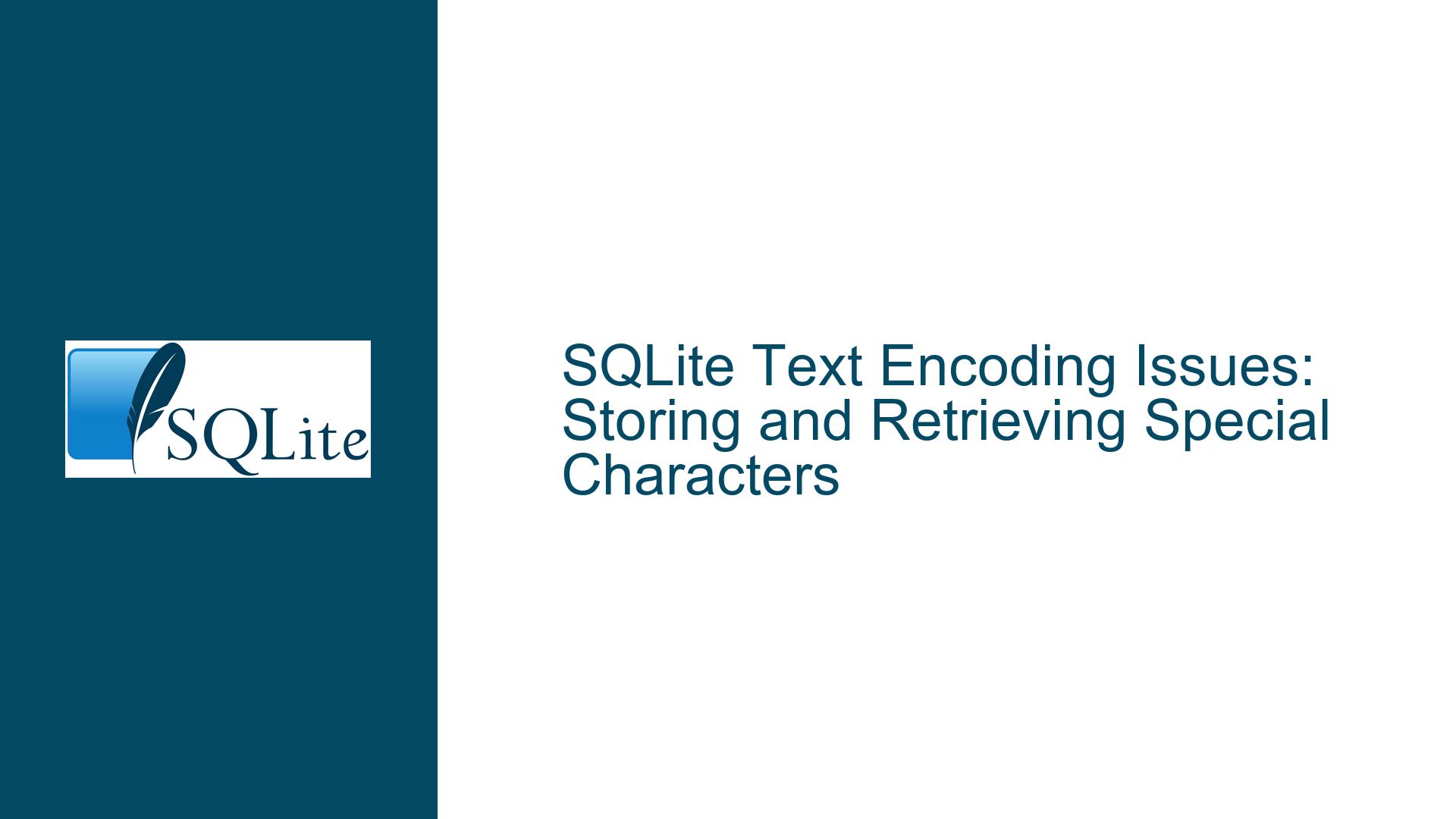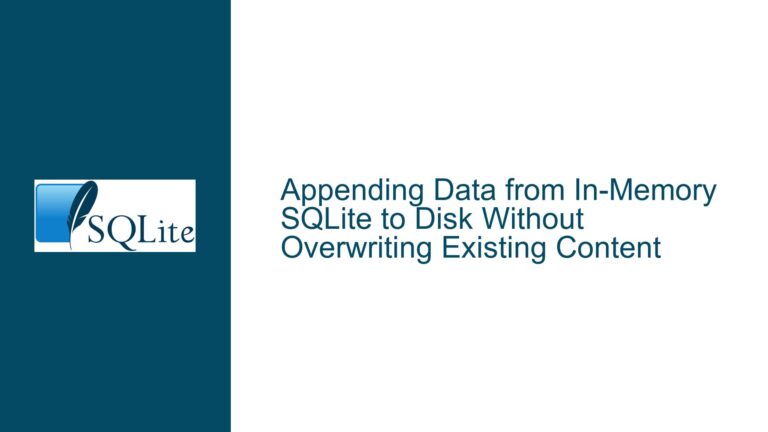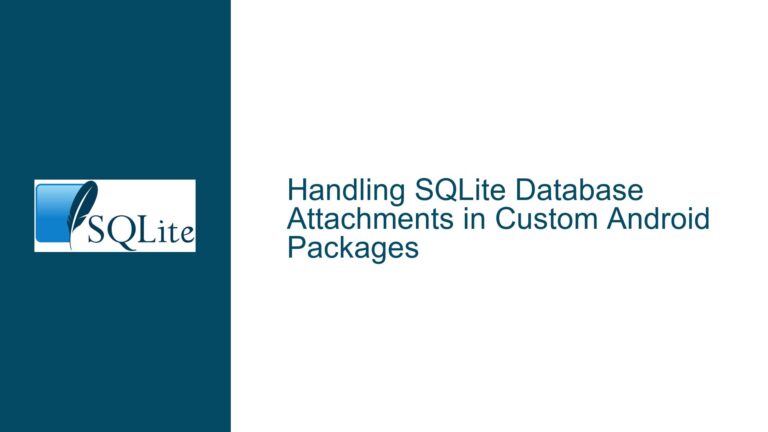SQLite Text Encoding Issues: Storing and Retrieving Special Characters
UTF-8 Encoding Mismatch in SQLite Text Columns
When working with SQLite, one of the most common issues developers encounter is the improper handling of special characters, such as trademark symbols (e.g., "®"), in text columns. This issue often manifests when the text being stored is not properly encoded in UTF-8, which is the default encoding expected by SQLite. The problem becomes evident when the data is retrieved and displayed, as the special characters may appear as garbled or incorrect symbols (e.g., "▒" instead of "®"). This issue is particularly prevalent when dealing with non-ASCII characters, which require multi-byte encoding in UTF-8.
The core of the problem lies in the fact that SQLite does not enforce a specific encoding for text data. Instead, it stores the exact sequence of bytes provided by the application. When these bytes do not conform to the expected UTF-8 encoding, the resulting data can be misinterpreted by SQLite’s command-line tool or other applications that assume UTF-8 encoding. This can lead to confusion, especially when the data appears correct in one context (e.g., a database browser) but incorrect in another (e.g., the SQLite command-line interface).
Invalid Byte Sequences in UTF-8 Encoding
The primary cause of this issue is the presence of invalid byte sequences in the text data being stored in SQLite. UTF-8 is a variable-width encoding, meaning that different characters require different numbers of bytes to represent. For example, ASCII characters (0-127) are represented by a single byte, while characters outside this range require multiple bytes. The trademark symbol "®" (U+00AE) is one such character, which should be encoded as the two-byte sequence "0xC2 0xAE" in UTF-8.
However, if the text data is not properly encoded in UTF-8, SQLite will store the raw bytes as provided. In the case of the trademark symbol, if the application provides the single byte "0xAE" instead of the correct two-byte sequence, SQLite will store this byte as-is. When the data is later retrieved and interpreted as UTF-8, the byte "0xAE" is not a valid UTF-8 character, leading to display issues such as the appearance of "▒" in the SQLite command-line tool.
This issue is compounded by the fact that SQLite does not perform any validation or conversion of text data when it is inserted into the database. The responsibility for ensuring that the text data is correctly encoded lies entirely with the application. If the application provides text data in an encoding other than UTF-8, or if it provides invalid UTF-8 sequences, SQLite will store the data without any warnings or errors. This can lead to subtle bugs that are difficult to diagnose, especially when the data appears correct in some contexts but not in others.
Ensuring Proper UTF-8 Encoding and Retrieval in SQLite
To resolve this issue, it is essential to ensure that all text data being stored in SQLite is properly encoded in UTF-8. This can be achieved by carefully managing the encoding of text data in the application before it is passed to SQLite. Here are the steps to ensure proper UTF-8 encoding and retrieval:
Validate Text Encoding Before Insertion: Before inserting text data into SQLite, the application should validate that the text is properly encoded in UTF-8. This can be done using libraries or functions that check for valid UTF-8 sequences. For example, in Python, the
encodemethod can be used to convert text to UTF-8, and any invalid sequences will raise an exception. Similarly, in C/C++, libraries such as ICU (International Components for Unicode) can be used to validate and convert text to UTF-8.Convert Text to UTF-8: If the text data is not already in UTF-8 encoding, it should be converted before being passed to SQLite. This is particularly important when dealing with text from external sources, such as files or user input, which may be in a different encoding. Most programming languages provide built-in functions or libraries for converting text between different encodings. For example, in Python, the
encodemethod can be used to convert text to UTF-8, while in C/C++, libraries such asiconvcan be used for this purpose.Use SQLite’s Built-in UTF-8 Functions: When retrieving text data from SQLite, it is important to use functions that correctly interpret the data as UTF-8. For example, the
sqlite3_column_textfunction in the SQLite C API returns a pointer to the raw bytes stored in the database. If the data is not valid UTF-8, it may be misinterpreted when displayed or processed. To avoid this, the application should ensure that the data is correctly interpreted as UTF-8 before using it.Handle Encoding in the SQLite Command-Line Tool: The SQLite command-line tool assumes that text data is encoded in UTF-8. If the data is not valid UTF-8, it may display incorrectly. To avoid this, the application should ensure that all text data is properly encoded in UTF-8 before inserting it into the database. Additionally, when using the command-line tool, the
.modeand.encodingcommands can be used to control how text data is displayed. For example, the.mode columncommand can be used to display text data in a more readable format, while the.encoding utf8command ensures that the data is interpreted as UTF-8.Use PRAGMA Statements to Control Encoding: SQLite provides several PRAGMA statements that can be used to control how text data is handled. For example, the
PRAGMA encodingstatement can be used to set the default encoding for new databases. By setting the encoding to UTF-8, the application can ensure that all text data is stored in the correct encoding. Additionally, thePRAGMA foreign_keysstatement can be used to enforce referential integrity, which can help prevent data corruption that may result from encoding issues.Test with Special Characters: To ensure that the application correctly handles special characters, it is important to test with a variety of characters, including those outside the ASCII range. This can help identify any issues with encoding or retrieval before they become problematic in production. For example, the application should be tested with characters such as "®", "©", and "™", as well as characters from non-Latin scripts, such as Chinese, Japanese, and Arabic.
By following these steps, developers can ensure that text data is correctly encoded and retrieved in SQLite, avoiding issues with special characters and ensuring that the data is displayed correctly in all contexts. This is particularly important when working with internationalized applications, where text data may include a wide variety of characters from different scripts and languages.
In conclusion, the issue of improper text encoding in SQLite is a common but easily avoidable problem. By understanding the requirements of UTF-8 encoding and taking steps to ensure that text data is correctly encoded and retrieved, developers can avoid the pitfalls associated with special characters and ensure that their applications work correctly with SQLite. This not only improves the reliability of the application but also enhances the user experience by ensuring that text data is displayed correctly in all contexts.






